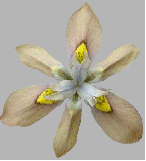|
In the garden
I would classify these Moraea species as easy-care, low-maintenance garden plants. The flowers are always beautiful and eye-catching, and the extra-long leaves of some species are a curiosity. They survive in our garden with -5C during some winter nights, and like to remain undisturbed for a number of years.
They are planted in the same general soil mix we use for most of our bulbs - a mixture of good loam, a bit of milled composted pine bark, well-matured garden compost and a bit of coarse river sand. To this we add general fertilizer (2:3:2) and bone meal. The main soil requirement for these plants is excellent drainage - most are grown in slightly raised beds. We have almost-dry winters, with good rains in summer, about 900 mm per year. They like full sun and breezy conditions. Although in nature M. huttonii grows on stream banks (in full sun), in our garden they are not given extra water more than the other species (all rely on natural rainfall) and thrive in semi-shade. I doubt that they would grow well in a greenhouse - any comments from the readers?
If they are to be grown in containers, these species will need to be in 25-35 cm pots, the larger size especially for the clump-forming ones. And remember to keep the containers cool by shading them from the sun - in nature the corms are in permanently cool to cold mountain soil. They need to be well watered from spring to autumn, and not allowed to dry out in winter.
Seeds germinate readily, any time from spring to late summer. Seedlings stay evergreen during their first year or two (in a seed tray out of the frost), and in the garden thereafter they are usually evergreen except for M. graminicola and M. muddii, which are deciduous.
They don't seem to be particularly susceptible to pests and diseases - so far we haven't needed to treat them for any ailments.
A quick guide to the Stutterheim yellow Moraea species
Moraea huttonii
Flower Time: Aug - Sep
Solitary Plant: clump forming
Branched Stem: mostly branched
Leaf Width: 10-25 mm
Other Features: stream banks
Moraea muddii
Flower Time: Sep - Oct
Solitary Plant: yes
Branched Stem: no
Leaf Width: 3-6 mm 40 cm tall
Other Features: Rare
Moraea spathulata
Flower Time: Oct - Nov
Solitary Plant: clump forming
Branched Stem: no
Leaf Width: 1.5 cm (w) 2+ m long
Other Features: Rare
Moraea graminicola ssp. notata
Flower Time: Nov - Jan
Solitary Plant: yes
Branched Stem: very rarely
Leaf Width: 10-12 mm
Other Features: Greyish flw rare
Moraea reticulata
Flower Time: Feb - May
Solitary Plant: yes, with basal net
Branched Stem: no
Leaf Width: 1.5 cm (w)2+ m long
Other Features: Mt slopes, endemic
References
Goldblatt, Dr P. 1986. The Moraeas of Southern Africa. Annals of KIRSTENBOSCH Botanic Gardens, Vol. 14.
Obermeyer, A. A. 1968. Moraea graminicola in Flowering Plants of Africa, Vol. 39, parts 1 & 2. Botanical Research Institute, Pretoria.
Obermeyer, A. A. 1970. Moraea huttonii in Flowering Plants of Africa, Vol. 40, parts 3 & 4. Botanical Research Institute, Pretoria.
Pearse, R. O. 1976. Mountain Splendour. Howard Timmins, Cape Town.
Pooley, E. 1998. Wild Flowers of KwaZulu-Natal and the Eastern Region. Natal Flora Publications Trust, Durban.
You can view these plants in their wild habitats
by joining a botanical tour offered by African Bulbs
HOMEPAGE BACK BOTANICAL TOURS
|
|



